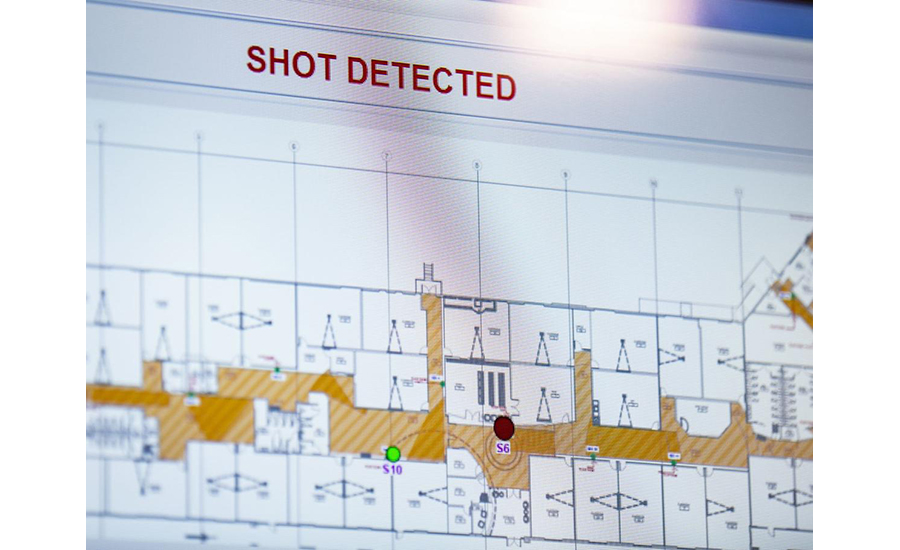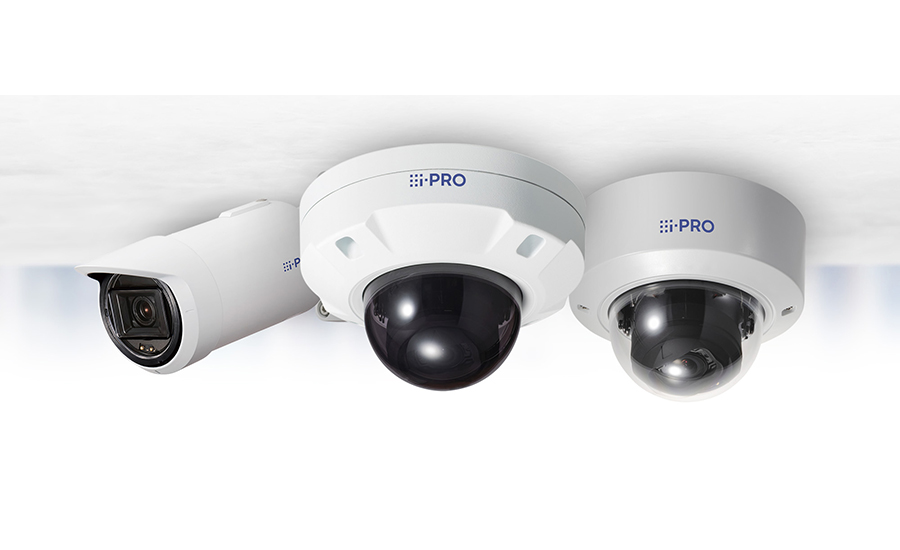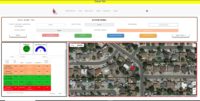In places like Chicago and other large cities where gun violence is high, technologies for detecting gunshots are important threads in the complex fabric of policing. While the merits of gunshot detection systems are sometimes challenged, their effectiveness is largely undisputed. In an article published by ABCNews in October 2022, Chicago’s Police Superintendent David Brown referred to the city’s gunshot detection system as an “intelligence network” that plays a big role not only in how law enforcement responds to and solves crimes but in how it helps prevent them, too.
Following their success in municipal applications, gunshot detection systems began to gain attention in commercial market segments such as K-12 education and retail. That has led to the solution’s growth and, thus, opportunities for security integrators not only for providing detection and notification, but for participating in conversations of a wider scope involving shooting prevention in general.
Among integrators, Milwaukee-based Johnson Controls is a leader in implementing gunshot detection solutions for its customers, having been reselling them for five years to markets such as education, warehousing, distribution centers, and transportation. “We knew that we needed to embrace emerging technologies and go more digital,” explains Anthony Seiler, director of vertical markets, USA Education, Johnson Controls. “And we also realized that we had nothing in our portfolio to offer in this space. We found a harmony within both of those, about the company’s decision to take on gunshot products.”
For Johnson Controls, this opened the door to a wider array of products for advanced weapons detection. Seiler says the company observed a shift in the market from interest in reactionary (after a gun is fired) measures to preventative (before a gun is fired) approaches. “So, if we can utilize gunshot detection, yes. But also, within other solutions [such as] artificial intelligence and behavioral analytics, to get 35 seconds ahead of where we’ve been historically, we’re finding that the market is open to that — and it’s been a really comprehensive conversation,” Seiler says.

SDS software displays the shot location on a floor plan map as well as triggers an audible “shot detected” message for the user. The software integrates with third-party systems such as video and access control. // IMAGE COURTESY OF SHOOTER DETECTION SYSTEMS
Why Gunshot Detection Is Good for Integrators
Gunshot detection solutions actually fit well in a security integrator’s product portfolio and business model. Not only is the technology easily understood — especially for those who have installed other types of sound detection — but it can be integrated with other security products and help the integrator stand out from the crowd, says Joe Byron, vice president of sales at Shooter Detection Systems (SDS), an Alarm.com company based in Rowley, Mass.
In many cases, gunshot detection can offer recurring revenue either through central station monitoring, a testing and maintenance plan, or both. “Just like a fire alarm system, indoor gunshot detection systems should be inspected at least once a year,” Byron explains. “This testing and verification service is an additional revenue source for dealers.”
Gunshot detection also can lead to more expansive discussions and potential future business. Byron has helped facilitate active shooter drills in the K-12 market, which includes police and emergency response teams working with district school administrators and school resource officers (SROs). “This is another opportunity for the [integrator] to showcase their expertise and sometimes meet potential customers from other school districts. Carrying a gunshot detection system also allows the [integrator] to start a security assessment discussion from a different angle. For example, did the client have a security audit performed recently? If so, what were the audit recommendations for an active shooter? Simple questions like these open the door for a holistic discussion to addressing multiple security threats — and highlight [an integrator’s] advanced service offerings,” Byron says.
SDS offers a system of indoor sensors and software that automatically detects, verifies and notifies users when a firearm has been discharged within a building. The company’s patented sensor uses two different types of detection technologies to identify and validate that a gunshot has occurred. The first component is a sensor designed to capture the acoustic signature of a gunshot; the second component is an infrared sensor designed to recognize the heat signature released when a gun is fired. Algorithms within the sensor analyze both signals to confirm that a gun has been discharged, with all this occurring in less than one second. When confirmed, simple text data such as sensor location, time and building location are instantly transmitted to clients, security teams or law enforcement, Byron says.

SDS software sends SMS text messages to a pre-configured list of contacts, alerting them of shot detected status and other data. // IMAGE COURTESY OF SHOOTER DETECTION SYSTEMS
The ability to integrate a gunshot detection system with a host of security technologies that integrators already work with is a huge value-add for customers, says Paul Mascari, director of security solutions, ShotSpotter, Fremont, Calif. He says ShotSpotter’s technology can be easily integrated with video management, access control, mass notification systems, and other technology platforms and when integrated, data on a gunshot’s location and time enhances the response and investigative follow-up to an incident. Gunshot detection technology is a requirement in an increasing number of requests for security proposals across many vertical markets, he notes.
“According to the Brookings Institution, more than 80 percent of gunfire incidents go unreported to 911,” Mascari says. “ShotSpotter is an acoustic gunshot detection system that fills that data gap by alerting police of virtually all gunfire in a coverage area within 60 seconds — enabling a fast, precise security or police response, ultimately helping save lives and collect critical evidence for investigations.
The way ShotSpotter works is through an array of acoustic sensors installed at the top of buildings or on utility poles in an area the customer designates. These sensors listen for loud, impulsive sounds that may be gunfire. Once captured, ShotSpotter’s computers then dismiss sounds that clearly are not gunfire, such as fireworks or helicopters. The remaining sounds are immediately sent to and reviewed by highly trained acoustic experts at the company’s 24/7 Incident Review Centers, Mascari explains. They either publish the incident to the customer as gunfire, or dismiss it as a non-gunfire event.
Assessing Which Gunshot Detection System to Resell
As part of discovering whether a gunshot detection solution can add value to an integrator’s offering, they should assess how these solutions fit within their particular vertical markets. “What type of business or estate is the proper target for this type of solution?” asks Bill Hobbs, vice president of global sales at 3xLOGIC, Fishers, Ind. (See sidebar, “Where Public Safety Meets Situational Awareness.”)
Further, integrators should seek to understand how gunshot detection plays into their customer’s overall security solution, Hobbs says. “Is the device effective and immune to false alarms? Is it easy to deploy and maintain? Does the customer understand clearly what they need and what to expect from this type of solution?”

The i-PRO S Series line of cameras includes sound classification analytics when used in conjunction with an external microphone. // IMAGE COURTESY OF I-PRO AMERICAS
3xLOGIC offers two gunshot detection solutions: an 8-sensor device for large spaces with 360-deg., 75-ft. radius coverage; and a single-sensor device for smaller spaces, which can be mounted in the corner of a room. Each uses a patented concussive wave sensor technology that detects the shockwave created when a bullet leaves the chamber of a firearm. This technology can detect gunfire within the sensing range of the device with near superior accuracy, Hobbs says. “By not relying on sound or a visual flash, the 3xLOGIC Gunshot Detection sensor is impervious to external interference from things other than gunfire.”
The 3xLOGIC devices can integrate with virtually any external alerting or control system such as video, access control, intrusion, and mass notification systems via either a dry contact closure or an IP data integration, Hobbs says. Upon quickly and accurately detecting the gunshot, an alert can be triggered to a monitoring center or a video surveillance or access control system.
David Antar, president of IPVideo Corporation, Bay Shore, N.Y., says some other common questions to ask when assessing products are: Will the system be used indoors or outdoors? What is the response time needed? Does the customer want to recognize multiple weapon and ammunition types? What are the false positives that can be expected and how can they be avoided? Has the technology been independently tested and what are the results of those tests?
IPVideo Corporation’s gunshot detection is currently implemented as part of its HALO IoT Smart Sensor, which includes a patented gunshot detection sensor technology among its features. The technology analyzes four characteristics of a detected audio signal: amplitude, decay rate, frequency spectrum, and pulse time (duration). If all four characteristics match, then the event is classified as a gunshot and the HALO will trigger notifications via email, text and integration with third-party emergency communications and/or security systems, Antar explains. The HALO device can be integrated with and configured to trigger facility lock-downs including door access, strobe lights, audible announcements and digital messages.
Most customers are interested in the accuracy level of detection and location, emphasizes Shawn Kermani, manager of product management at i-PRO Americas, Houston. “When it comes to resellers assessing products, it’s important to set expectations, as no system is perfect,” Kermani says. “Any detection system can generate false positives, so it’s critical to have a strategy in place to verify any such alarms before taking significant actions such as lockdowns.”
i-PRO provides an AI sound classification function built into its AI cameras. Together with an external or built-in microphone, the camera can detect and classify important sounds such as a gunshot, yelling, vehicle horn and glass-breakage. The AI camera processes sound classification at the edge, comparing the sound signature with known sound profiles. When a match is made, a gunshot alarm is sent to the VMS to alert operators to take immediate action. i-PRO’s Active Guard plugin provides comprehensive integration of AI-based object recognition with attributes and sound classification on popular VMS platforms including Video Insight, Genetec, Milestone, and ASM300, Kermani describes.
Gunshot detection sensor is located in the ceiling on the upper left at the Georgia World Congress Center in Atlanta. // IMAGE COURTESY OF SHOOTER DETECTION SYSTEMS
There are several measurements that Johnson Controls uses when researching a vendor to represent to its clients, whether it’s gunshot detection or another product, explains Joshua Pearson, digital services manager at Johnson Controls. Firstly, “They have to be an established vendor with experience that can be measured; their technology has to be proven with successful installations,” Pearson says.
There must be various levels of cybersecurity protections. Integrations and open platforms also are crucial for a vendor’s technology to be able to integrate with Johnson Controls’ building technologies or other building systems. The concept of providing visibility of various subsystems through one central pane of glass is key to making a customer’s building “come alive” with information, Pearson describes.
Johnson Controls’ vendors also must share a similar vision around security and life safety, he says. “At JCI, we pride ourselves on protecting and securing our customers, both in the physical space as well as in the digital space or the virtual space,” Pearson adds. “So, it really is imperative that our vendors and our partners share that same commitment to customer safety that we share and that we express every day.”

HALO 3C is the latest version of IPVideo’s HALO IoT Smart Sensor, a security device for privacy areas where cameras and microphones are not allowed. With a single device HALO provides gunshot detection as well as building health monitoring, indoor air quality monitoring, vape detection, THC detection, and many more conditions. // IMAGE COURTESY OF IPVIDEO CORPORATION
Advice & Tips for a Successful System
Selecting a gunshot detection solution to add to your product portfolio isn’t only a reflection of your company; it can be a matter of life and death to your customer.
“Speed is key,” Seiler says. “Make sure your solution is alerting authorities fast and efficiently. If you’re in education, figure out what that workflow of communication looks like, and make sure it’s fast, it’s tested and it’s proven. And anyone that sets up solutions like these will run test after test, after test. Communications are probably the most important thing.
“In a situation where a gunshot goes off, no one has any time to think. You can’t be running around with ands and ums, and figuring out what that process is. It’s already too late. So, picking a solution that has speed, that has integration capabilities, that’s user-friendly, and that easily streamlines the communication process makes it easy for anyone to interpret — those are the things that we look at and would recommend to anybody,” he says.
Pearson emphasizes the criticality of alerting time. “The most important thing really during these events is time. A system that can report a threat faster, with more pinpoint accuracy as to the event’s actual location, can dramatically change the outcome, right? Two seconds versus eight seconds really can make a dramatic difference during an emergency event like this,” he says.










